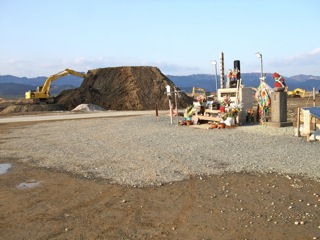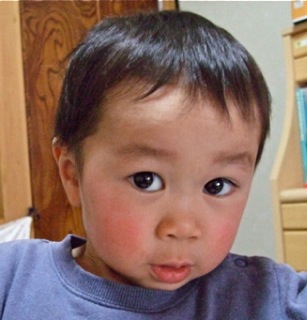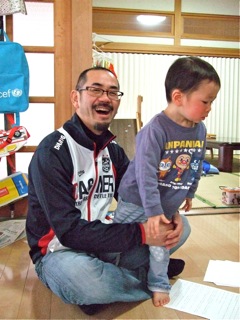Ishinomaki: 11 Months After the Tsunami
- At March 01, 2012
- By admin
- In Annes Letters
 0
0

One of the most unsettling and surprising things in eastern Tohoku is the unevenness of the clean up work. A once damaged area may be pretty much bare by now. But even so, there might be an apartment building still standing with people living on the top floors. The rest of the structure might be broken and smashed up, but the second or third stories might have laundry hanging out on the veranda. Or a bicycle might be leaning against a wobbly pole that more or less held up the entire building.
I went to Ishinomaki last September and was shocked by the extent of the destruction in the area near the port. The hospital was in complete shambles and next to it a pharmacy tilted knee deep in water. There were frames of houses and piles of debris everywhere. And along one whole side of this expansive, tragic mess was a wall of bent and crunched vehicles. There were cranes and backhoes working constantly to gather rubbish, as trucks plied back and forth removing what had been collected.
At that time a sense of deep and ongoing emptiness could be felt everywhere. It was as if the souls of the recently deceased were lost and wandering hither and yon trying to find something familiar to hold on to. The effect on the living was eerie and haunting, worrisome and deeply sad.
Six months later, almost a year since the Great East Japan Earthquake and Tsunami smashed into people’s ordinary lives, I ventured back to Ishinomaki to see how things were progressing. I was expecting the entire area near the sea to be cleared away, but to my amazement nothing seemed to have changed much. The shattered hospital that had visited me over and over again in my dreams was boarded up and roped off, but otherwise unchanged.
The buildings around it were still there, all worse for wear. Mud had turned to green slime and mold. And amazingly one vacated house, its windows intact and open, had curtains flapping in the fiercely cold strong winds of late winter. The school that had caught fire was still standing with its charred black empty face staring out to sea.
But as I looked more carefully, I realized most of the cranes had completed their major tasks and had moved on. Also I did not find the makeshift altar where the frantic noodle shop owner had showed me where his restaurant had once stood. But I did come across a newly erected stone slab with a Buddha carved on it. It stood alone and humble within the expansive area of house frames and scattered stones. In fact, it seemed to be an anchor collecting and comforting what was left of all that shattering.
The place itself felt empty this time. No spirits wandering, no howling, no cries of grief. Simply empty. Simply sad. With fringes of deep, unspoken depression and also wonder. Wonder as to what would become of that area, as to how the city officials would rebuild that land so close to the unpredictable, dangerous, yet abundant sea.
A Japanese friend who teaches in Ishnomaki kindly drove me up the coast so I could see what life there had become. That coastline was a series of coves, which before the tsunami had been pocketed with small fishing villages. Most were part of Ishinomaki City, but one large chunk was Onnagawa, where a now-closed nuclear power plant stood. Fortuitously that plant was high up and had been closed for inspection just before the tsunami. So unlike its Fukushima counterpart, it had not caused any problems. It remains closed, however.
Happily, even though there were no houses left in those small coves, we did see many working oyster boats bobbing in the waters nearby. That encouraging sign meant that slowly fishermen were getting back to the sea and trying to make a living from it once again.
There is a terrible problem of what to do with all the rubbish that is still accumulating as the clearing out process soldiers on. We noticed that a few of the once beautiful larger coves had been turned into rubbish dumps. In fact, the famous bus perched on top of a three-story building in Ogatsu was still there, looking out over mountains of debris.
Other prefectures refuse to take rubbish from Tohoku. They fear nuclear contamination. Unfortunately, not only foreigners, but also many Japanese lump Tohoku into one huge area of contamination. Depending on who and where people are, opinions about the extent of the radiation vary greatly. Here is an amusing picture of those differences.
From top left to bottom right:
Top row:
1 = viewed by Tohoku People
2 = viewed by Kanto People (near Tokyo)
3 = viewed by Hokkaido People
4 = viewed by TEPCO People (Tokyo Electric Power Company)
Bottom row:
5 = viewed by Kansai People (Western Japan)
6 = viewed by Okinawa People
7 = viewed by The Rest of the World
8 = viewed by Japanese Politicians
This applies not only to rubbish but also to all products from this region. People are reluctant to buy agricultural goods, seafood, and meat. They choose not to come near this once popular area, despite its many scenic spots, delicious food, and salt-of-the-earth people. That means, of course, that the economic future of this region is very uncertain. Jobs that are emerging are individual and scattered. People who lost homes cannot afford a second mortgage to buy another one. School enrollments are down, some as much as 50%. The suicide rate is climbing.
My friend’s home is just across the river from the Okawa Elementary School, where almost all the children, obeying evacuation procedures perfectly, were unable to escape and drowned. That tragic place is standing, but mostly ruins now. There is a small altar in front of the ruins, where hundreds of people have come to witness and to pray.
Since that incident was so shocking, and since it left such a deep and disturbing impact on people’s psyches, extra effort is being made to find and honor the bones of those very young victims. So far all but four have been retrieved. And the search goes on. When I was there, a backhoe was ever so carefully scraping down a hill of rubble, hoping to come across fragile human bones. If none or not all are found, there is talk of blocking off and draining that part of the river to allow a very thorough search. For Japanese this process is vitally important. How else can they properly honor the souls of their loved ones, allowing them to enter eternity in peace?
Although my friend lives in Ishinomaki, he had not been along that coast route for many months. “I was incredibly busy after the tsunami ruined much of my home,” he explained. “So all I did for four months was to clean up the mess. Now I’m exhausted – physically and emotionally – and all I want is to live a normal life again.
“Also my priorities really changed because of all this. Before I was keenly focused on my career. I still care about my job and my students, of course, but they simply don’t hold me like they used to. I have two kids, aged four and two, and I want to spend as much time with them as I can. I love being a father and I want to be fully involved in the privilege and joy of that.”
He took me to his home and walked me through the long hard process of cleaning it up after the tsunami waters stood in it for two weeks. “I sent my wife and children to her family home. And then I worked from dawn to dusk. I shoveled out mud and threw away almost everything. It was backbreaking, but you know, I loved it. I simply focused and went to work. I adored the clarity of purpose. And because of that I had more energy that I think I ever had. It was great.
“I’d go to the volunteer center to ask for help on occasion. But mostly I worked by myself. When my wife came back, we would go to the center where there were piles of donated items. We got sleeping mats for the kids there and other useful things. Also a friend from Sendai gave me old tatami mats, so we did not have to buy much. Actually, we don’t need or want much these days.
“This old house used to belong to my grandparents. All the years we lived here – first me, later my wife, and later still my kids – the walls were dark and dreary and the place was full of their stuff. So for us the tsunami was a wonderful opportunity to start afresh. As you can see, the walls are now white and we have only what we need and no more. The space and sense of lightness are exhilarating.
“We know the future is very uncertain. How long will my university stay open with so few students applying now? How long will we be able to stay here? We don’t know anything for certain. But I do know that I am happy this day. My wife and kids help to make me so.”
Then he looked at me very thoughtfully and said, “Yes, at this point in my life I feel like the happiest man in the world.”
To help those still in need in Japan, please consider buying Letters to the Ground from the Heart or donating to the cause. 100% of the proceeds will be distributed to survivors of The Great East Japan / Tohoku Earthquake and Tsunami, most notably the Sendai Yomawari Group that serves the homeless—a population which is now exploding.















